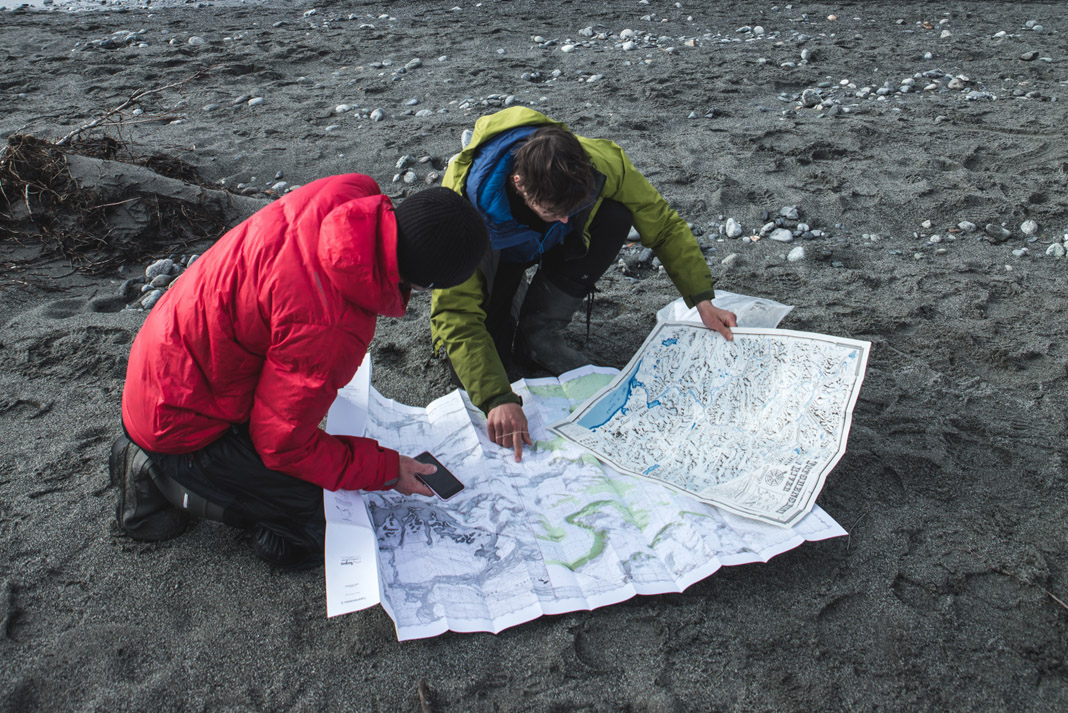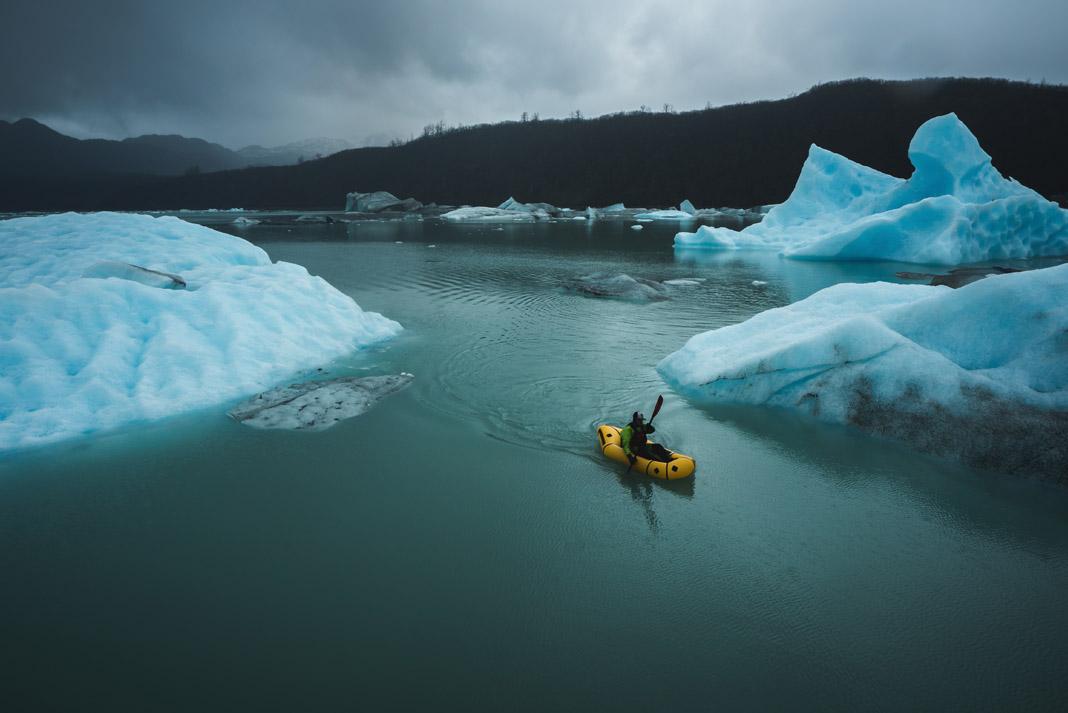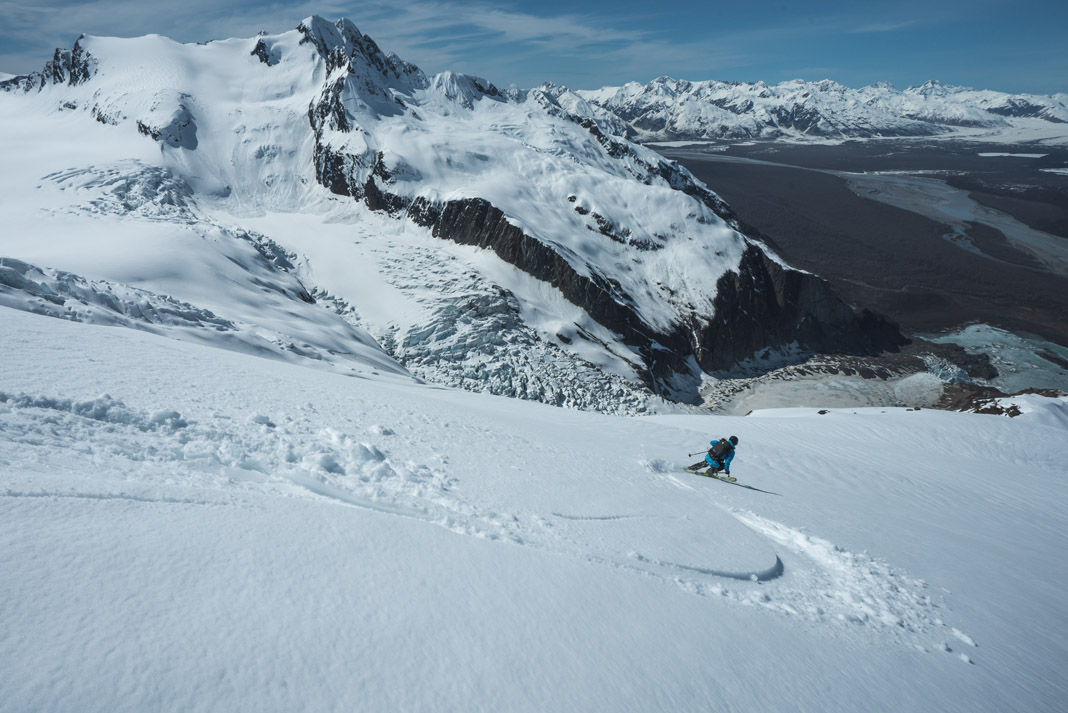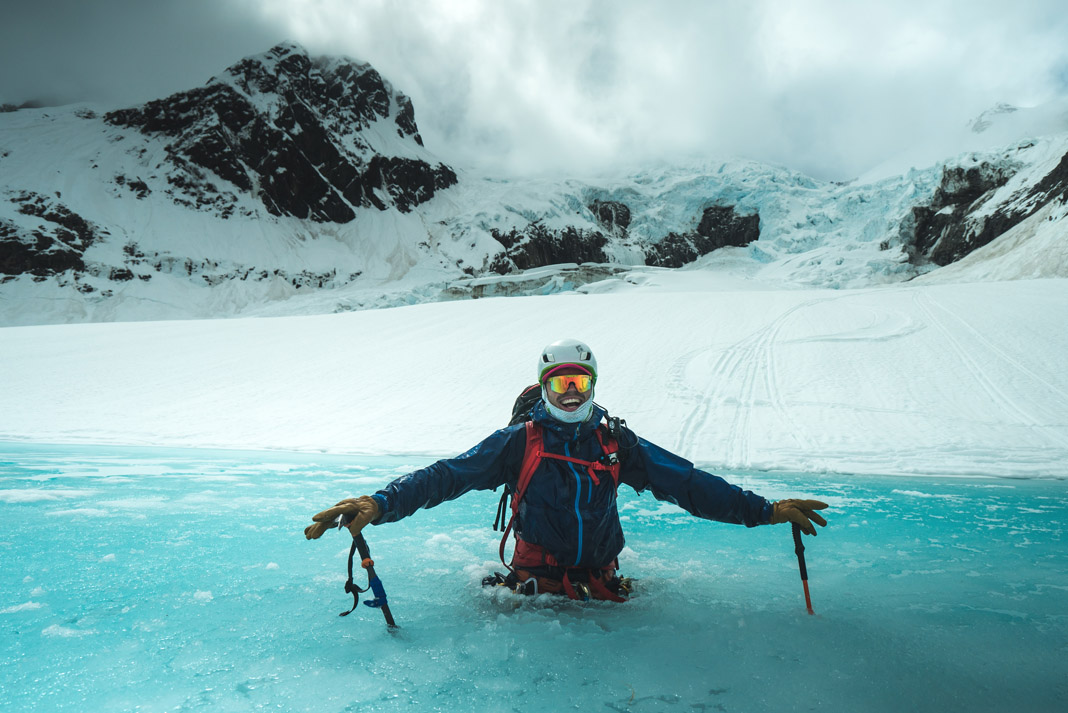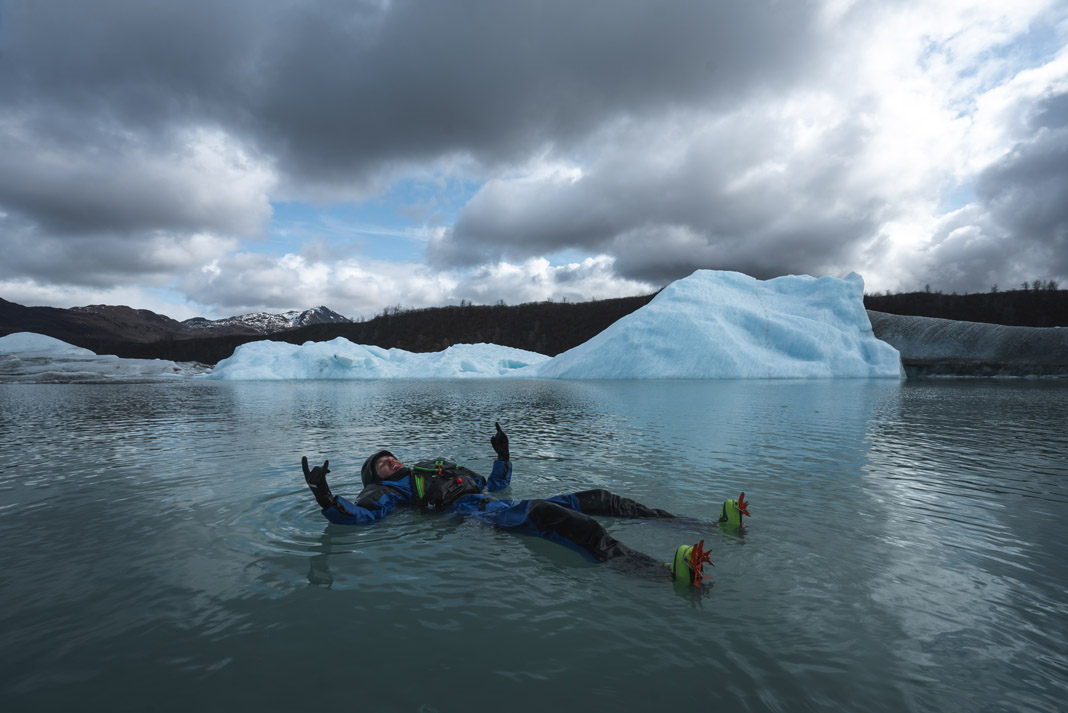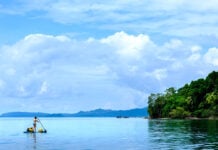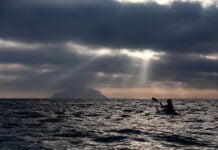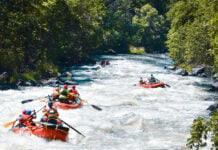Dirty chai latteeeee for Thomas!” he screamed in a high-pitched voice. We were a long, long way from a hipster coffee shop in downtown Seattle. Earlier that morning we had broken through the frozen headwaters of the Tatshenshini River, a 150-kilometer river tracking from the Yukon through British Columbia, to the ocean in Alaska.
The zero-degree wind was whipping my face, and two-meter-thick walls of ice lined the banks. I was surrounded by nine soon-to-be best friends, bobbing in the frigid water in bright neon green and blue drysuits. A couple were preparing hummus wraps and chai lattes using Jet Boils, while others shot film with one of three drones.
I watched as refrigerator-sized ice chunks floated by our eddy, then glanced up to see Sam surfing one. I wondered what the pioneers and First Nations who originally used this river as a coastal trading route would have thought of this neon team of Teletubbies navigating their river, bantering and bullshitting for 21 days. I didn’t worry about it though—my abs were already too sore from laughing.
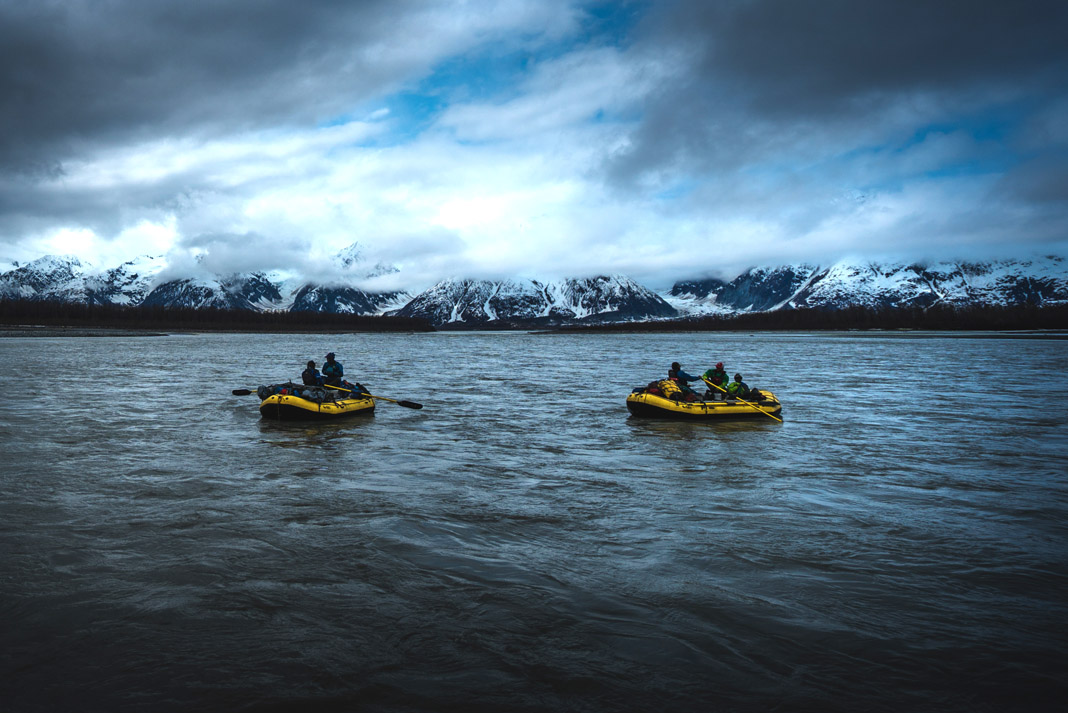
Months prior, I had watched the gears turn in my friend Mason’s head as he pulled a tattered Tatshenshini guidebook off the shelf at a used book store in Bellingham, Washington. When Mason asked me to join him and eight other friends on this trip—what was essentially his bachelor party—my first thought was, “Mason is stupid for inviting me on this.” I am a professional forester and a mountain biker who spends a lot of time outside, but I was unprepared for a trip with this crew of superstar filmmakers, boaters, climbers and skiers, whose motto might as well be misery makes memories.
Nonetheless, I got down on my knees and begged for a month off work. The plan was to take three weeks over late April and early May to paddle down the Tatshenshini and Alsek rivers and ski the steep faces of the mountains directly into the waters. Joey Schusler, a professional adventure filmmaker and good friend, would document the trip and turn it into a film for Five Points Film Festival. Hours spent pouring over old guidebooks and Google Earth made it seem like our route was possible, though we also knew we were planning to put onto the river two months earlier than any other trip had.
My friends at home were encouraging and told me it was going to be the trip of a lifetime. What I didn’t mention were the fears bubbling up the more research we did—persistent frigid temperatures, spring storms, avalanche cycles, grizzly bears coming out of hibernation, raft-sucking ice bridges across the river, and most of all, the group dynamics in serious and unfamiliar terrain.
A week before the trip we were told by a bush pilot that large portions of the river were still frozen over. The group started mentally preparing for plan B, which involved dragging the loaded rafts using ski touring gear along or beside the frozen river until it was thawed enough to put in. All told, a fairly miserable prospect.
A day before arriving in Whitehorse we learned the river had thawed significantly, and there were now only a few ice bridges that could be an issue. We all breathed a sigh of relief.
I got to the put-in where the other nine guys waited without a clue about what just happened. What could go wrong on this trip, eh?
On D-day, the route to our put-in was four-kilometers long and covered in deep, soft snow. Bob and Kevin Daffe, owners of Tatshenshini Expediting, took care of us by assisting with a generation’s worth of knowledge about the river, nearly all of our gear and escorting us via school bus and snowmobile 240 kilometers from Whitehorse to the put-in.
The 10 of us dragged three rafts, 10 pairs of skis with accompanying backcountry gear, 21 days of food, all our paddling gear, and what seemed like a Hollywood production’s worth of camera gear down to the put-in using snowmobiles and hunting sleds. After hours of lapping back and forth, I felt at ease to be finally moving after the months of planning and anticipation.
On my final snowmobile lap, I slowed down a little to admire the sight of the sun dipping behind the mountains when the fully loaded sled with all of our food started passing me. I throttled as hard as I could on the steep downhill to whip the sled back behind me and maintain the tension on the rope. It swung back and forth violently, nearly tipping over as I leveled off, flying at 50 kilometers an hour. I got to the put-in where the other nine guys waited without a clue about what just happened. What could go wrong on this trip, eh?
We apprehensively dipped our feet into the frigid water of the Tatshenshini on a clear, still Yukon morning. The sun was soft on the horizon, and the trickling river was covered in thick sparkling ice on both sides. Black cottonwoods and willows with small buds, still brittle from the long winter, dominated our peripheries. Less than a minute after boarding the raft and starting the journey, we were back out, wading through slushy water, trying to break up the frozen chunks in front of us, and squeezing our boats through the ice on both sides of the river. The rafts rumbled along cobbles in just a couple of inches of water. It was going to be a very long journey at this pace.
We pulled over occasionally to scout more turbulent rapids and ensure our rafts weren’t going to get sucked under the ice. As we got further in and the river opened up a bit, we were able to spend longer periods of time without having to manhandle the rafts. However, the air and water were so cold that if we didn’t have to push the rafts, we were frozen from not moving. I was wearing two fleece onesies beneath my drysuit and felt like a popsicle.
We coped with this by leaving one man on the oars of each raft while the remaining seven of us ran along the ice banks for kilometers at a time, warming our legs and bodies. Valuable—and hilarious—coping mechanisms emerged as we got into the flow of things: tea breaks, push-up breaks, the occasional on-raft-nap. My initial fears of the unknown on this trip eased, along with the rest of the team. We developed a rhythm of floating six to 10 hours a day and then setting up camp. We scouted rapids and potential ice bridges from over a kilometer out using drones paired with iPhones—a luxury the Tlingit traders on this route never had.
Our kitchen department was robust: rotations of wild rice gouda-cheese pancakes, nightly beers, and scratch-made brownies were a regular part of our diet. Good food was essential to keeping morale high in the cold.
We ran the river at faster speeds than anticipated, and after less than a week we had powered past some of our planned campsites. Somewhere near the British Columbia border, the wide-open landscape of the Yukon gave way to the steep mountains of the Coastal Mountain Range. On another clear bluebird day, we drifted down the river to see glistening snow running from high summits right down to the river—time to go skiing and we were stoked. We had grand plans of skiing glaciers and claiming epic first descents on couloirs spitting out right on the river.
We spent our first day skiing and touring on the Netland Glacier amidst stunning terrain of a magnitude none of us had experienced before. We worked hard to get it, with a two-hour, spirit-breaking bushwhack through willows, slide alder, and thorny hawthorne on the approach. It was the perfect opportunity to work out how we would manage our group of 10—practicing crevasse rescue and rope skills, how we would split based on skill levels, and ironing out the rough bits of our soon-to-be-frequent skiing procedure.
We woke to a flooded camp, displaced rafts, river water just a few meters from our tents, and more roaring.
After our first learning day on the glacier, we spent the evening eyeing up more ski objectives, pouring over contour maps and old notes in our tents. And then the pitter patter of rain began. It rained hard through the night, and to our dismay, it kept on, hard and consistent for days. We passed the time reading, cooking and sleeping hard. I peered out from my tent one morning after what sounded like the roar of a jet engine taking off from just around the corner—it turned out to be a flock of a few hundred Canada geese, startled by someone taking a piss.
As the rain continued, the mood started to dip amongst the crew, and on the second night of straight rain, the roar of what I thought were more geese seemed to go all through the night. We woke to a flooded camp, displaced rafts, river water just a few meters from our tents, and more roaring. As the light came into our deep valley, we saw that the roar was not geese but avalanches of saturated snow. Massive debris torrents ran down every mountainside.
When the weather let up, we finally made some moves. We were able to salvage some skiing by being creative, but a lot of our planned lines had been destroyed. We utilized the slide paths as access at times, and spent more time on glaciers instead of couloirs, staying on the flat and just skinning. A team worked hard to summit and ski a line proclaimed, “The Gomer’s Delight,” a mellow ridgeline on the horizon that we had spotted on Google Earth. I watched as the sun came out and the team ripped their skins. It was a magical feeling, sitting around our fire in the sand along the river, watching my ant-sized friends ski this visually stunning ridge, smoothly dancing their way down. We celebrated with a fire, burritos, and a Texas mickey of Crown Royal.
As the trip wound down, we had become an efficient machine, learning how to communicate as a team of 10, keep morale high, and navigate the river. By the time we reached the Alsek confluence, the river was running at least 30,000 cubic feet per second—by no means a trickle anymore. The Tatshenshini is unique in that it starts in the flat plains of the Yukon plateau, and as you drop in elevation, the mountains become bigger, finishing in Alsek Lake, where snow-covered peaks and colossal glaciers surround the iceberg covered lake on nearly all sides. The Alaskan coastline sits just 10 miles to the west of this lake where we would be picked up.
Less than an hour after setting up our camp beside this picturesque lake, we utilized our iceberg playground to the fullest. Looking back, I think we all let our guards down a bit because we were so near the take-out, but everyone was just so riddled with joy. It resulted in 10 neon goons surfing down chunks of ice on paddleboards, doing backflips into the lake, having dance parties, and going on casual swims down the river. We spent a bit too much time doing this, and after a long, cold, hilariously fun journey, we paddled our way out to the take-out where we were picked up by a cargo plane the following morning to be taken back to Whitehorse.
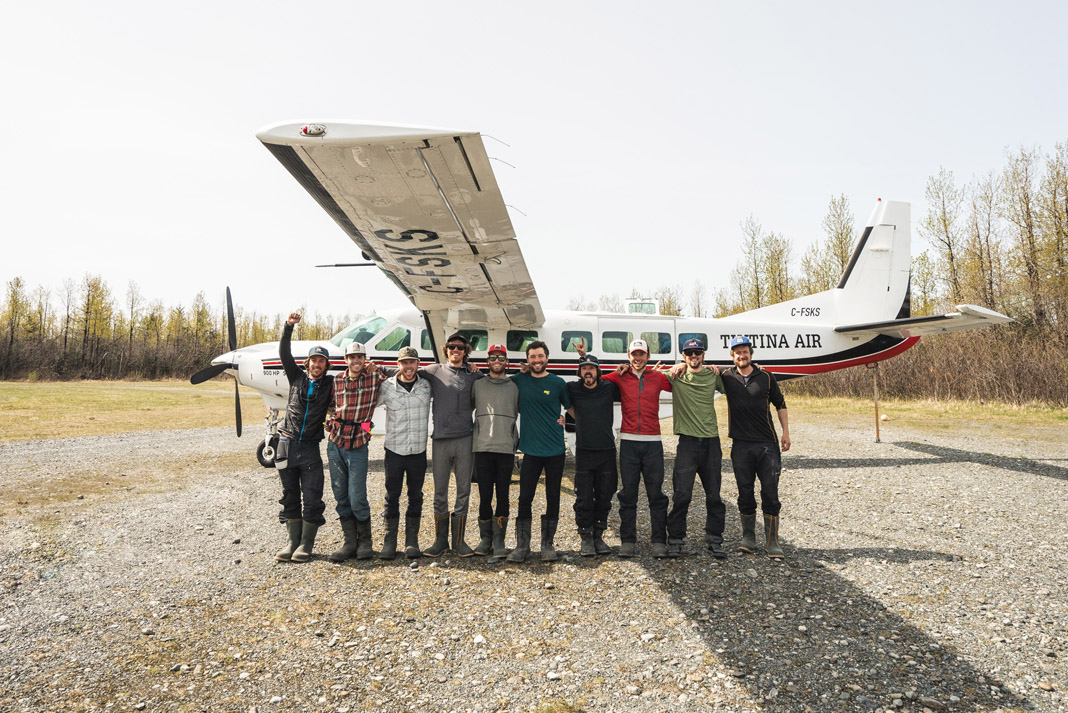
When my friends and family ask me about this trip, I could probably pump out a lot of stories about overcoming adversity—the extreme cold, long days in the tent waiting out the rain, the risks of being way, way out there with nine others. But when I look back, an image comes to mind of Joey in his bright green drysuit, beer in hand, leading nine of us through a yoga class on the ice bank of the river, and I smile.
Misery makes memories? Sure, but that’s not what I choose to remember. I remember pure, type-one fun.
Evan Powell lives in British Columbia, where he’s a professional forester and lover of all adventures.



